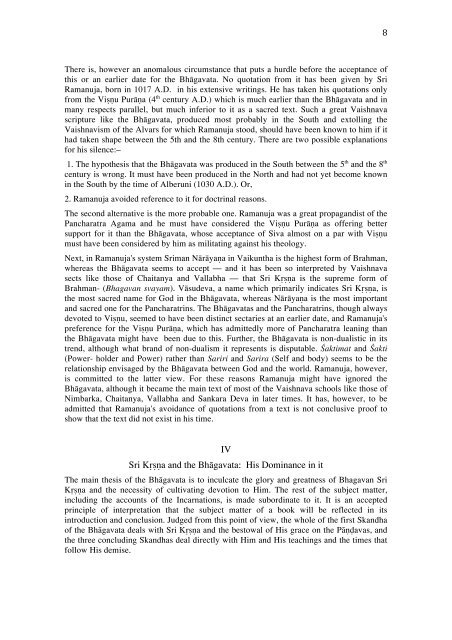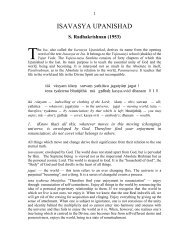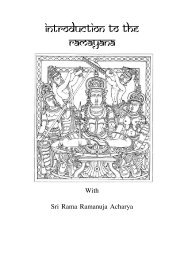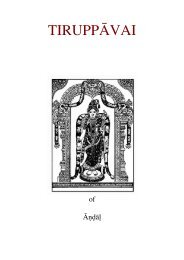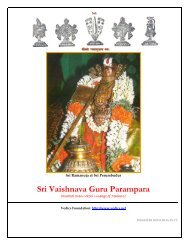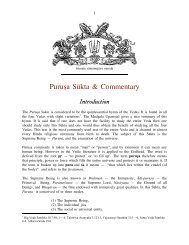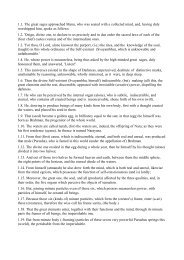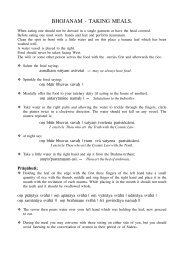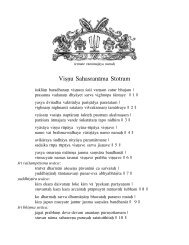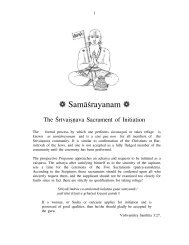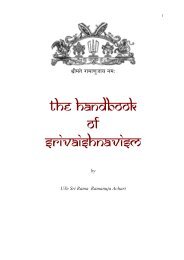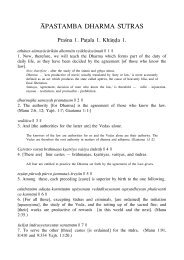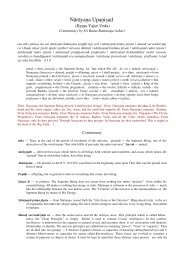8 There is, however an anomalous circumstance that puts a hurdle before the acceptance ofthis or an earlier date for the Bhāgavata. No quotation from it has been given by SriRamanuja, born in 1017 A.D. in his extensive writings. He has taken his quotations onlyfrom the Viṣṇu Purāṇa (4 th century A.D.) which is much earlier than the Bhāgavata and inmany respects parallel, but much inferior to it as a sacred text. Such a great Vaishnavascripture like the Bhāgavata, produced most probably in the South and extolling theVaishnavism of the Alvars for which Ramanuja stood, should have been known to him if ithad taken shape between the 5th and the 8th century. There are two possible explanationsfor his silence:–1. The hypothesis that the Bhāgavata was produced in the South between the 5 th and the 8 thcentury is wrong. It must have been produced in the North and had not yet become knownin the South by the time of Alberuni (1030 A.D.). Or,2. Ramanuja avoided reference to it for doctrinal reasons.The second alternative is the more probable one. Ramanuja was a great propagandist of thePancharatra Agama and he must have considered the Viṣṇu Purāṇa as offering bettersupport for it than the Bhāgavata, whose acceptance of Siva almost on a par with Viṣṇumust have been considered by him as militating against his theology.Next, in Ramanuja's system Sriman Nārāyaṇa in Vaikuntha is the highest form of Brahman,whereas the Bhāgavata seems to accept — and it has been so interpreted by Vaishnavasects like those of Chaitanya and Vallabha — that Sri Kṛṣṇa is the supreme form ofBrahman- (Bhagavan svayam). Vāsudeva, a name which primarily indicates Sri Kṛṣṇa, isthe most sacred name for God in the Bhāgavata, whereas Nārāyaṇa is the most importantand sacred one for the Pancharatrins. The Bhāgavatas and the Pancharatrins, though alwaysdevoted to Viṣṇu, seemed to have been distinct sectaries at an earlier date, and Ramanuja'spreference for the Viṣṇu Purāṇa, which has admittedly more of Pancharatra leaning thanthe Bhāgavata might have been due to this. Further, the Bhāgavata is non-dualistic in itstrend, although what brand of non-dualism it represents is disputable. Śaktimat and Śakti(Power- holder and Power) rather than Sariri and Sarira (Self and body) seems to be therelationship envisaged by the Bhāgavata between God and the world. Ramanuja, however,is committed to the latter view. For these reasons Ramanuja might have ignored theBhāgavata, although it became the main text of most of the Vaishnava schools like those ofNimbarka, Chaitanya, Vallabha and Sankara Deva in later times. It has, however, to beadmitted that Ramanuja's avoidance of quotations from a text is not conclusive proof toshow that the text did not exist in his time.IVSri Kṛṣṇa and the Bhāgavata: His Dominance in itThe main thesis of the Bhāgavata is to inculcate the glory and greatness of Bhagavan SriKṛṣṇa and the necessity of cultivating devotion to Him. The rest of the subject matter,including the accounts of the Incarnations, is made subordinate to it. It is an acceptedprinciple of interpretation that the subject matter of a book will be reflected in itsintroduction and conclusion. Judged from this point of view, the whole of the first <strong>Skandha</strong>of the Bhāgavata deals with Sri Kṛṣṇa and the bestowal of His grace on the Pāṇḍavas, andthe three concluding <strong>Skandha</strong>s deal directly with Him and His teachings and the times thatfollow His demise.
9 The question of the Rishis of Naimisharanya, in answer to which Suta gives out theBhāgavata, is most exclusively related to Kṛṣṇa. They ask him:–"O Suta, tell us what was the purpose for which the Bhagavan was born inDevaki as the son of Vāsudeva? Tell us, who are endowed with spiritual zeal,about His noble and playful activities, of which sages have sung. Tell us aboutthe incidents of the Incarnation of Hari, wherein He manifested His playfulnature through His own mysterious power. We are never satisfied with hearingthe glorious activities of the Lord, the descriptions of which appear so sweet totrue connoisseurs at every stage. What superhuman acts did the Bhagavanperform along with Rama, having adopted the mask of a human body?" (1.1.12,17-20)The whole of the Bhāgavata is an answer to these questions,Further, the very reason which prompted Vyāsa to compose the Bhāgavata was the urge toproduce a devotional work excluslvelv devoted to the glorification of Vāsudeva. It is statedin the Bhāgavata that when Vyāsa was sitting in a mood of depression and dissatisfaction,and worrying himself to know the cause of it, the great Rishi Nārada appeared beforeVyāsa and informed him that the cause of his depression was the fact that in all his works,he had dealt only with human values, at best with slight touches of devotional element. Hesaid:–"You have not, O sage, described the transeerdent glory of Vāsudeva in anexhaustive manner as you have done with regard to Dharma (morality) andArtha (power)"And the consequence of this advice was the production of the Bhāgavata which describesitself as follows:–Further,“In other works the supreme Lord Hari, who destroys all the evils of the IronAge of Kali, has not been praised in all their parts, but in this narrative theBhagavan has been glorified in every word of it" (XII. 2.65).“When Kṛṣṇa disappeared from the world, and along with Him, Dharma andJñana, there arose this sun of the Bhāgavata Purāṇa as a guide to men caughtin the darkness of Kali (II.I.13). If a person studies or hears this text, describingthe activities of the Lord, the Bhagavan will very soon become manifest in hisheart. Having entered the heart through the ear. Kṛṣṇa purifies the mind as thespring season clarifies all the rivers. One whose mind has thus been purified,finds eternal rest at the feet of Kṛṣṇa as a traveller does on reaching home afterpassing through ever so many troubles and tribulations" (11.8.4-6)Not only in its purport, but even structurally, the Bhāgavata is dominated by the personalityof Sri Kṛṣṇa. Of its twelve <strong>Skandha</strong>s, the tenth and the eleventh, covering about one half ofthe whole text, deal with Kṛṣṇa's life and teachings, while the first two <strong>Skandha</strong>s stemdirectly from His life, and the third is a conversation between Vidura and Uddhava, twogreat contemporaries and devotees of Sri Kṛṣṇa.Sri Kṛṣṇa in Relation to the Mahā-Viṣṇu ConceptTaking all this into consideration, it has to be admitted that while the Bhāgavata is aVaishnava scripture, it is also undisputedly a text extolling His incarnation as Kṛṣṇa and the
- Page 3 and 4: 3 by turn, as it were, thus display
- Page 5 and 6: 5 Purāṇa, thus relegating the Vi
- Page 11: 11 Viṣṇu conception, and that i
- Page 18 and 19: 18 Cosmic History versus Modern Wor
- Page 20 and 21: 20 categories, the succeeding from
- Page 22 and 23: 22 the lie to the modern theory tha
- Page 24 and 25: 24 much vaunted historicity of Chri
- Page 26 and 27: 26 In an Introduction to a Text lik
- Page 28 and 29: 28 connoisseur of the sentiment of
- Page 30 and 31: 30 the Sattvika manifestation of V
- Page 32 and 33: 32 There is no Limit to the Number
- Page 34 and 35: 34 and divided by the good and kind
- Page 36 and 37: 36 joyous memory of His service, an
- Page 38 and 39: 38 asunder by roaming elephant herd
- Page 40 and 41: 40 means by which the darkness of i
- Page 42 and 43: 42 Suta said:- 40. Still Arjuna did
- Page 44 and 45: 44 22. Salutations to the One havin
- Page 46 and 47: 46 sorrow at, the death of all frie
- Page 48 and 49: 48 His mind was free from all sinfu
- Page 50 and 51: 50 11-12. Spiritual aspirants who h
- Page 52 and 53: 52 ever satisfied with his own blis
- Page 54 and 55: 54 Skandha 1: Chapter 12THE BIRTH O
- Page 56 and 57: 56 and returned to Hastinapura, hav
- Page 58 and 59:
58 them at His will. 41. Just as a
- Page 60 and 61:
60 Arjuna's Return in utter Distres
- Page 62 and 63:
62 sought by Indra and the Devas fo
- Page 64 and 65:
64 that state of absolute purity, w
- Page 66:
66 subject to any diminution in K
- Page 69 and 70:
69 degeneration. 6. No doubt Kali,
- Page 71 and 72:
71 connected with these crimes. Man
- Page 73:
73 Arrival of Sri Suka (25-40)25. W


